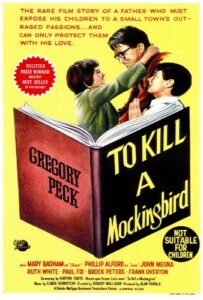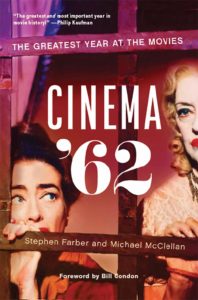Mar. 9, 2020 11:33 AM EDT
Review: Authors look at `The Greatest Year at the Movies’
By LEE D. MITGANG
Associated Press
“Cinema ’62: The Greatest Year at the Movies,” Rutgers University Press, by Stephen Farber and Michael McClellan
What was the greatest year in cinema history? Among film fans and critics, 1939 has long been a favorite pick. Hollywood’s studio system was at its peak that year and cranked out an astonishing number of crowd-pleasing, star-studded films including “The Wizard of Oz,” “Mr. Smith Goes to Washington,” “Ninotchka,” “Stagecoach” and “Dark Victory.” At the top of that formidable heap was “Gone with the Wind,” which won eight Oscars, including best picture.
A new history by Los Angeles film critics and scholars Stephen Farber and Michael McClellan offers a different and, for many, surprising alternative. In their audaciously titled “Cinema ’62: The Greatest Year at the Movies,” they argue that the early ‘60s in general – and 1962 in particular — deserve recognition not just for big-wave beach movies, but also for new-wave films from abroad and for the emergence of a generation of American auteurs who were fashioning a mold-breaking new Hollywood. Strictly by numbers, 1962 may not have produced as many enduring classics as 1939, a year that placed 19 films on the Library of Congress’ prestigious National Film Registry, more than twice the eight such films from 1962. But 1962’s importance rests on the artistic daring of its films, and on the unprecedented willingness of filmmakers to tackle taboo subjects at a time when the production codes and the censorious Legion of Decency still wielded influence on Hollywood producers and American audiences.
Echoing the emerging civil rights spirit of the early ‘60s, for example, “To Kill a Mockingbird” poignantly indicted racial injustice, though not without objections from film raters for its frequent use of the “n-word.” “Lolita” depicted an older man’s obsession with a preadolescent girl. The British import “A Taste of Honey” offered an unusually adult portrayal of homosexuality and scored well with audiences. Bosley Crowther, The New York Times’ powerful film critic, called it the year’s best film.
Hollywood’s studio system may have been declining in 1962 but reliable stars like Doris Day, John Wayne, James Stewart and Bette Davis still churned out an impressive number of hit films. Wayne and Stewart starred in director John Ford’s “The Man Who Shot Liberty Valance.” Screen veteran Rosalind Russell put an indelible stamp on the lead role of Rose in “Gypsy.” Davis and Joan Crawford gave unforgettably creepy performances in the psychological thriller “Whatever Happened to Baby Jane?,” whose poster the authors feature on their book jacket.
From abroad, filmmakers were drawing American audiences as never before with movies that broke new artistic ground. Among them were Federico Fellini (“La Dolce Vita”), Francois Truffaut (“Jules et Jim”), Tony Richardson (“The Loneliness of the Long Distance Runner”), Pietro Germi (“Divorce Italian Style”) and Michelangelo Antonioni (“La Notte”).
The authors add spice and credibility to their history with interviews of survivors of 1962 filmmaking, including Mariette Hartley who made her debut in director Sam Peckinpah’s “Ride the High Country”; Shirley Knight, who starred with Paul Newman in the sexually charged “Sweet Bird of Youth”; and Angela Lansbury, who gave a deliciously villainous performance in director John Frankenheimer’s “The Manchurian Candidate.”
The book ends with a chapter-long appraisal of David Lean’s “Lawrence of Arabia,” 1962’s most honored, commercially successful and technically dazzling film. It featured a sophisticated plot replete with political chicanery, colonialism and a subtle depiction of the title character’s homosexuality, and a superb cast of old hands like Claude Rains as well as relative newcomers Peter O’Toole and Omar Sharif. Yet fascinatingly, it drew only mixed reviews.
“Cinema ‘62” probably won’t end the “best-year-in-film” debate. But authors Farber and McClellan serve film fans a briskly written, meticulously researched history that gives an often-overlooked and underrated era in cinema its due. “Our hope,” the authors write, “is that those who still remember where they were in ’62 will relish the journey into the past, and other, younger readers will come to wish they were there, too.”




